Effective Communication in the Workplace: A Comprehensive Report
VerifiedAdded on 2020/05/16
|9
|1563
|84
Report
AI Summary
This report examines effective communication in the workplace, differentiating between verbal and nonverbal communication. It emphasizes the importance of nonverbal cues, including body language, personal appearance, touch, use of time and space, and vocal characteristics, especially in multicultural professional settings. The report also addresses corporate behavior, communication strategies, and dressing, highlighting their impact on professional image. It underscores the significance of intercultural communication, stressing the need for culturally competent verbal and nonverbal communication to avoid misunderstandings. The report concludes by emphasizing the importance of maintaining a professional image through behavior, communication, and appearance for successful business dealings in a globalized world.
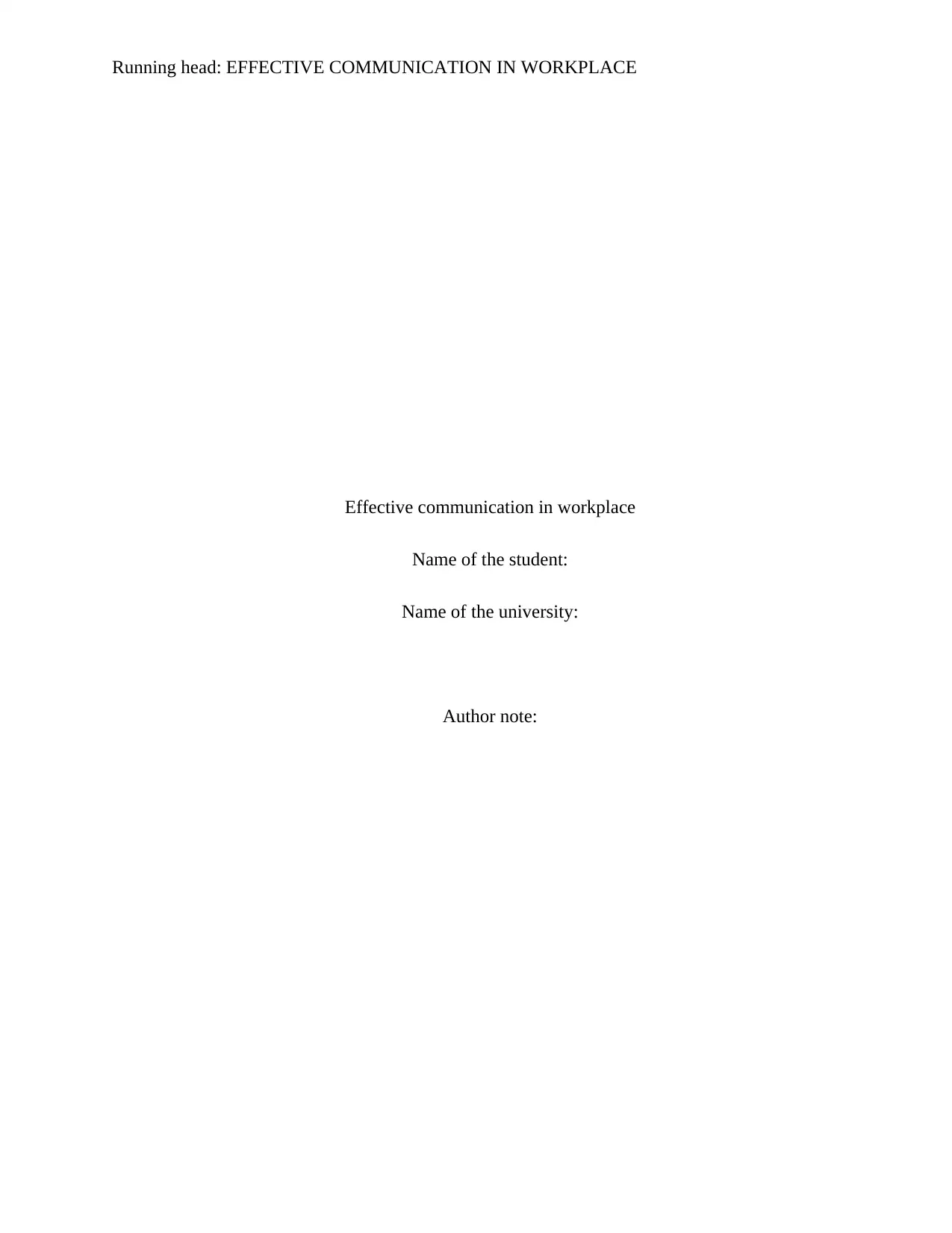
Running head: EFFECTIVE COMMUNICATION IN WORKPLACE
Effective communication in workplace
Name of the student:
Name of the university:
Author note:
Effective communication in workplace
Name of the student:
Name of the university:
Author note:
Paraphrase This Document
Need a fresh take? Get an instant paraphrase of this document with our AI Paraphraser
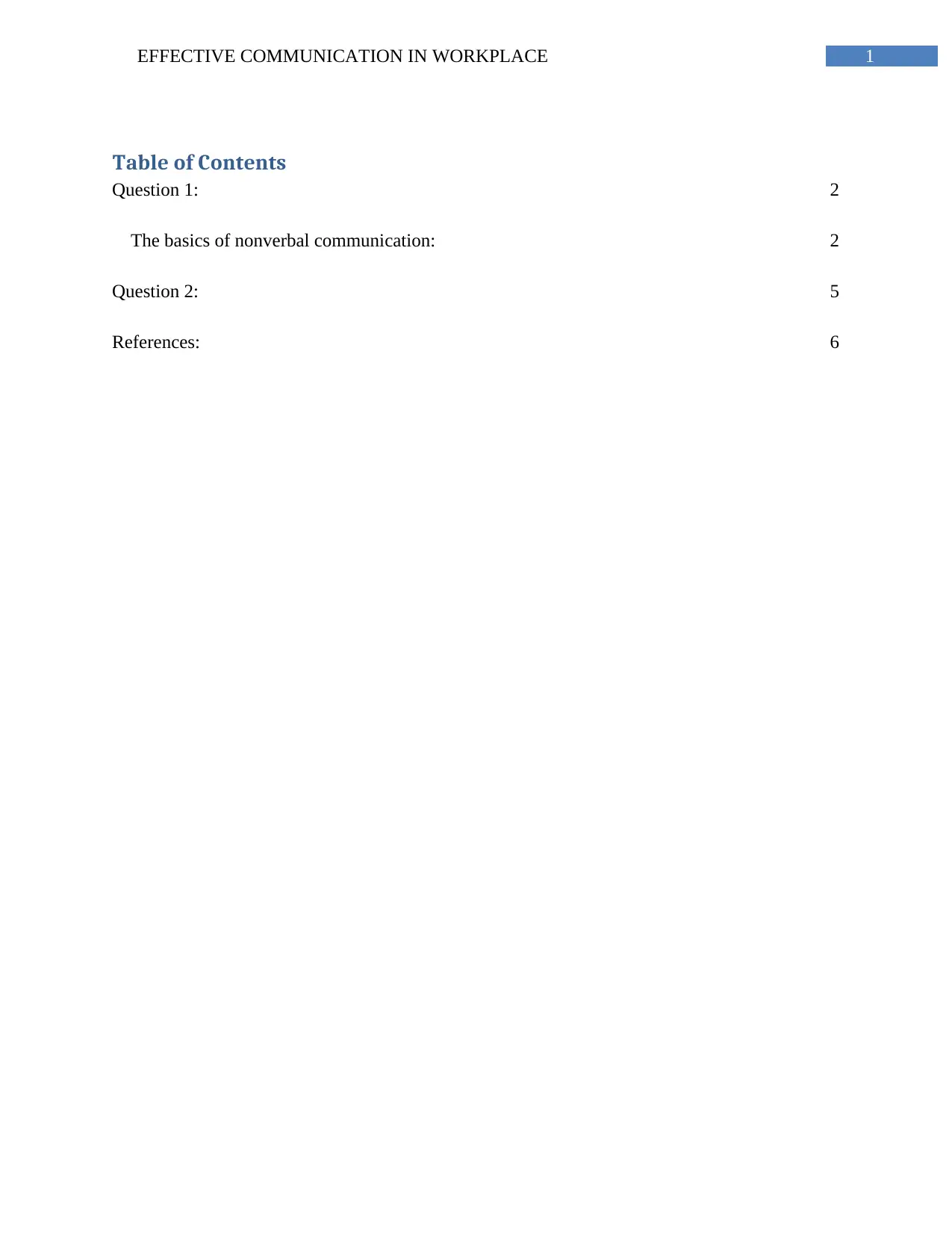
1EFFECTIVE COMMUNICATION IN WORKPLACE
Table of Contents
Question 1: 2
The basics of nonverbal communication: 2
Question 2: 5
References: 6
Table of Contents
Question 1: 2
The basics of nonverbal communication: 2
Question 2: 5
References: 6
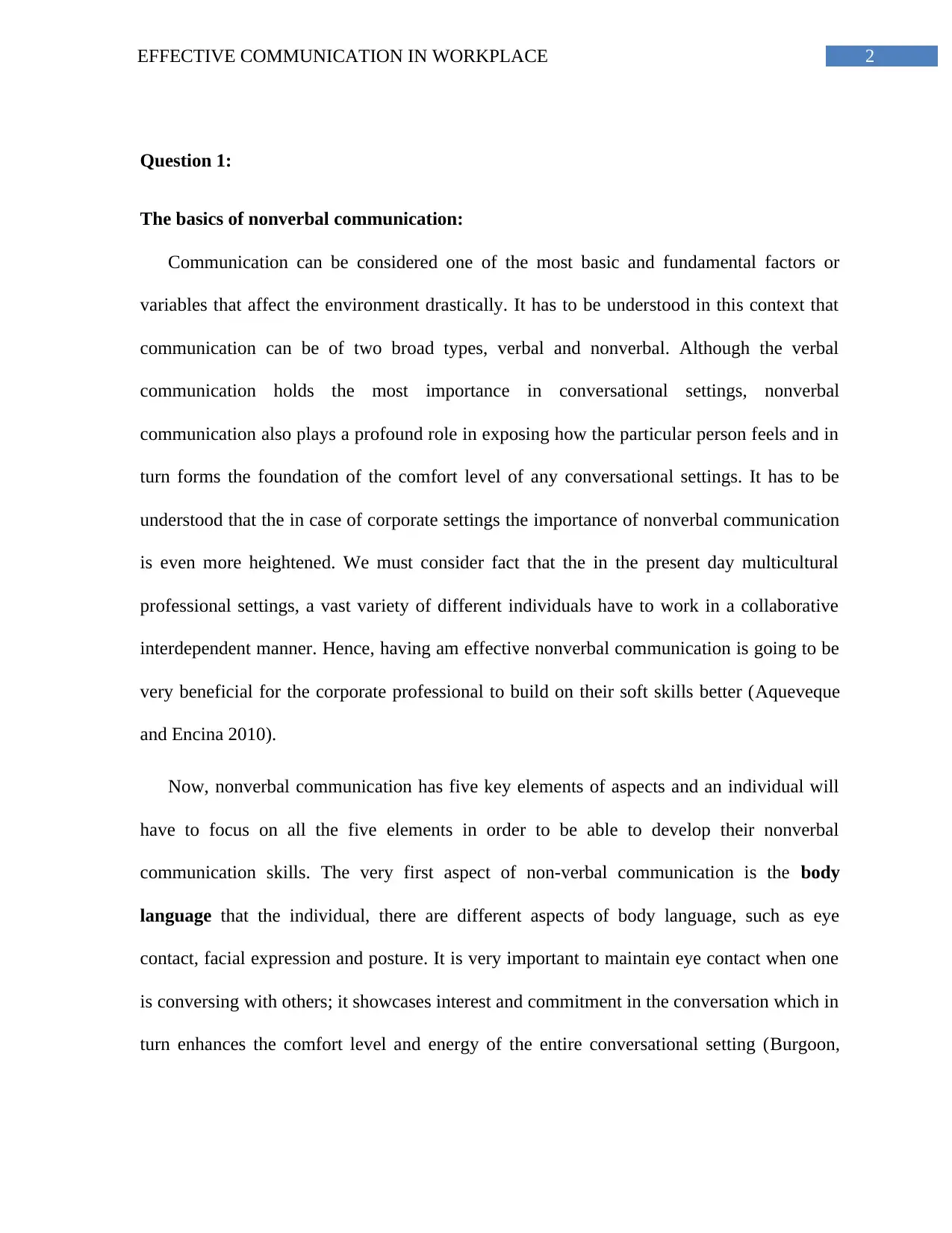
2EFFECTIVE COMMUNICATION IN WORKPLACE
Question 1:
The basics of nonverbal communication:
Communication can be considered one of the most basic and fundamental factors or
variables that affect the environment drastically. It has to be understood in this context that
communication can be of two broad types, verbal and nonverbal. Although the verbal
communication holds the most importance in conversational settings, nonverbal
communication also plays a profound role in exposing how the particular person feels and in
turn forms the foundation of the comfort level of any conversational settings. It has to be
understood that the in case of corporate settings the importance of nonverbal communication
is even more heightened. We must consider fact that the in the present day multicultural
professional settings, a vast variety of different individuals have to work in a collaborative
interdependent manner. Hence, having am effective nonverbal communication is going to be
very beneficial for the corporate professional to build on their soft skills better (Aqueveque
and Encina 2010).
Now, nonverbal communication has five key elements of aspects and an individual will
have to focus on all the five elements in order to be able to develop their nonverbal
communication skills. The very first aspect of non-verbal communication is the body
language that the individual, there are different aspects of body language, such as eye
contact, facial expression and posture. It is very important to maintain eye contact when one
is conversing with others; it showcases interest and commitment in the conversation which in
turn enhances the comfort level and energy of the entire conversational setting (Burgoon,
Question 1:
The basics of nonverbal communication:
Communication can be considered one of the most basic and fundamental factors or
variables that affect the environment drastically. It has to be understood in this context that
communication can be of two broad types, verbal and nonverbal. Although the verbal
communication holds the most importance in conversational settings, nonverbal
communication also plays a profound role in exposing how the particular person feels and in
turn forms the foundation of the comfort level of any conversational settings. It has to be
understood that the in case of corporate settings the importance of nonverbal communication
is even more heightened. We must consider fact that the in the present day multicultural
professional settings, a vast variety of different individuals have to work in a collaborative
interdependent manner. Hence, having am effective nonverbal communication is going to be
very beneficial for the corporate professional to build on their soft skills better (Aqueveque
and Encina 2010).
Now, nonverbal communication has five key elements of aspects and an individual will
have to focus on all the five elements in order to be able to develop their nonverbal
communication skills. The very first aspect of non-verbal communication is the body
language that the individual, there are different aspects of body language, such as eye
contact, facial expression and posture. It is very important to maintain eye contact when one
is conversing with others; it showcases interest and commitment in the conversation which in
turn enhances the comfort level and energy of the entire conversational setting (Burgoon,
⊘ This is a preview!⊘
Do you want full access?
Subscribe today to unlock all pages.

Trusted by 1+ million students worldwide
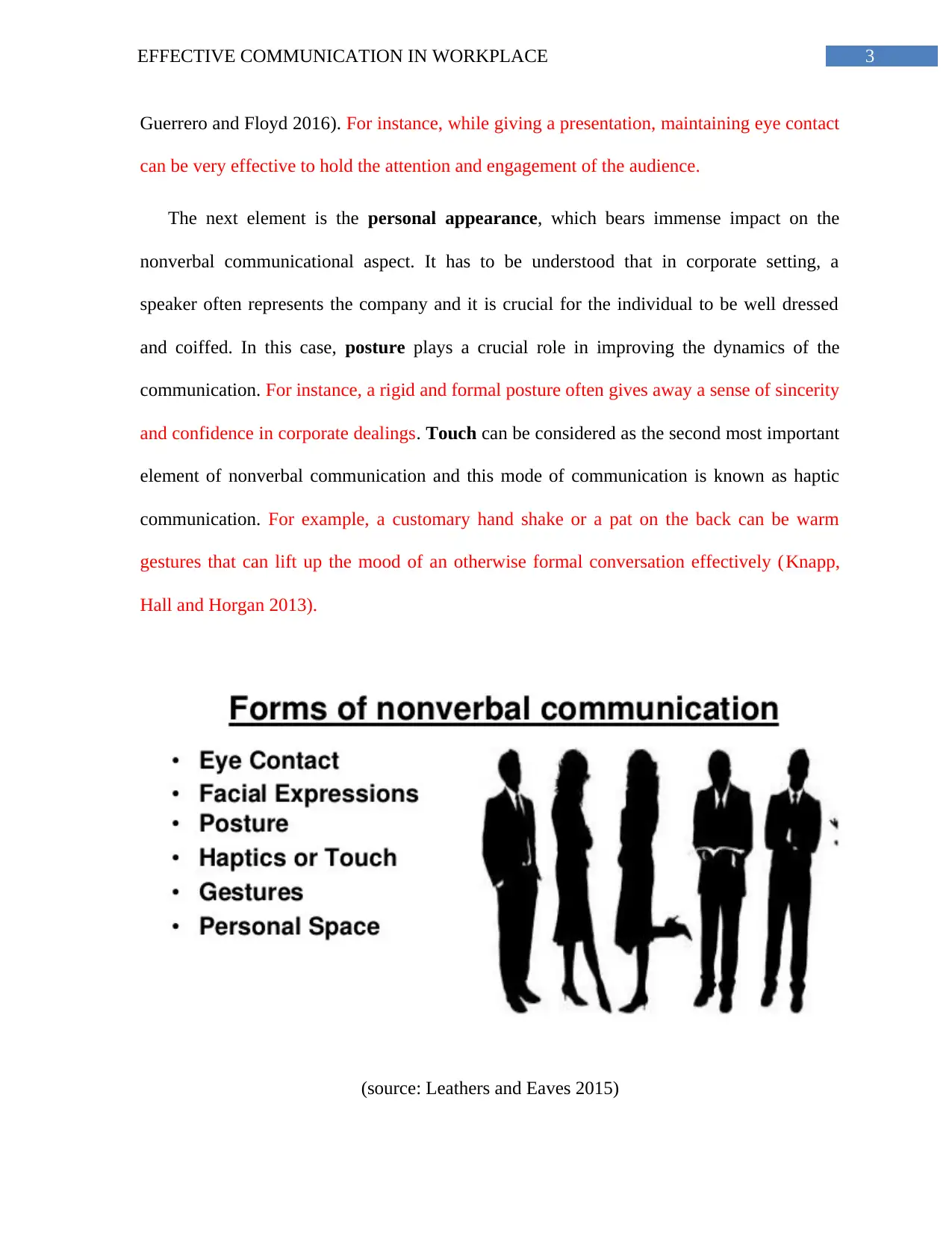
3EFFECTIVE COMMUNICATION IN WORKPLACE
Guerrero and Floyd 2016). For instance, while giving a presentation, maintaining eye contact
can be very effective to hold the attention and engagement of the audience.
The next element is the personal appearance, which bears immense impact on the
nonverbal communicational aspect. It has to be understood that in corporate setting, a
speaker often represents the company and it is crucial for the individual to be well dressed
and coiffed. In this case, posture plays a crucial role in improving the dynamics of the
communication. For instance, a rigid and formal posture often gives away a sense of sincerity
and confidence in corporate dealings. Touch can be considered as the second most important
element of nonverbal communication and this mode of communication is known as haptic
communication. For example, a customary hand shake or a pat on the back can be warm
gestures that can lift up the mood of an otherwise formal conversation effectively (Knapp,
Hall and Horgan 2013).
(source: Leathers and Eaves 2015)
Guerrero and Floyd 2016). For instance, while giving a presentation, maintaining eye contact
can be very effective to hold the attention and engagement of the audience.
The next element is the personal appearance, which bears immense impact on the
nonverbal communicational aspect. It has to be understood that in corporate setting, a
speaker often represents the company and it is crucial for the individual to be well dressed
and coiffed. In this case, posture plays a crucial role in improving the dynamics of the
communication. For instance, a rigid and formal posture often gives away a sense of sincerity
and confidence in corporate dealings. Touch can be considered as the second most important
element of nonverbal communication and this mode of communication is known as haptic
communication. For example, a customary hand shake or a pat on the back can be warm
gestures that can lift up the mood of an otherwise formal conversation effectively (Knapp,
Hall and Horgan 2013).
(source: Leathers and Eaves 2015)
Paraphrase This Document
Need a fresh take? Get an instant paraphrase of this document with our AI Paraphraser
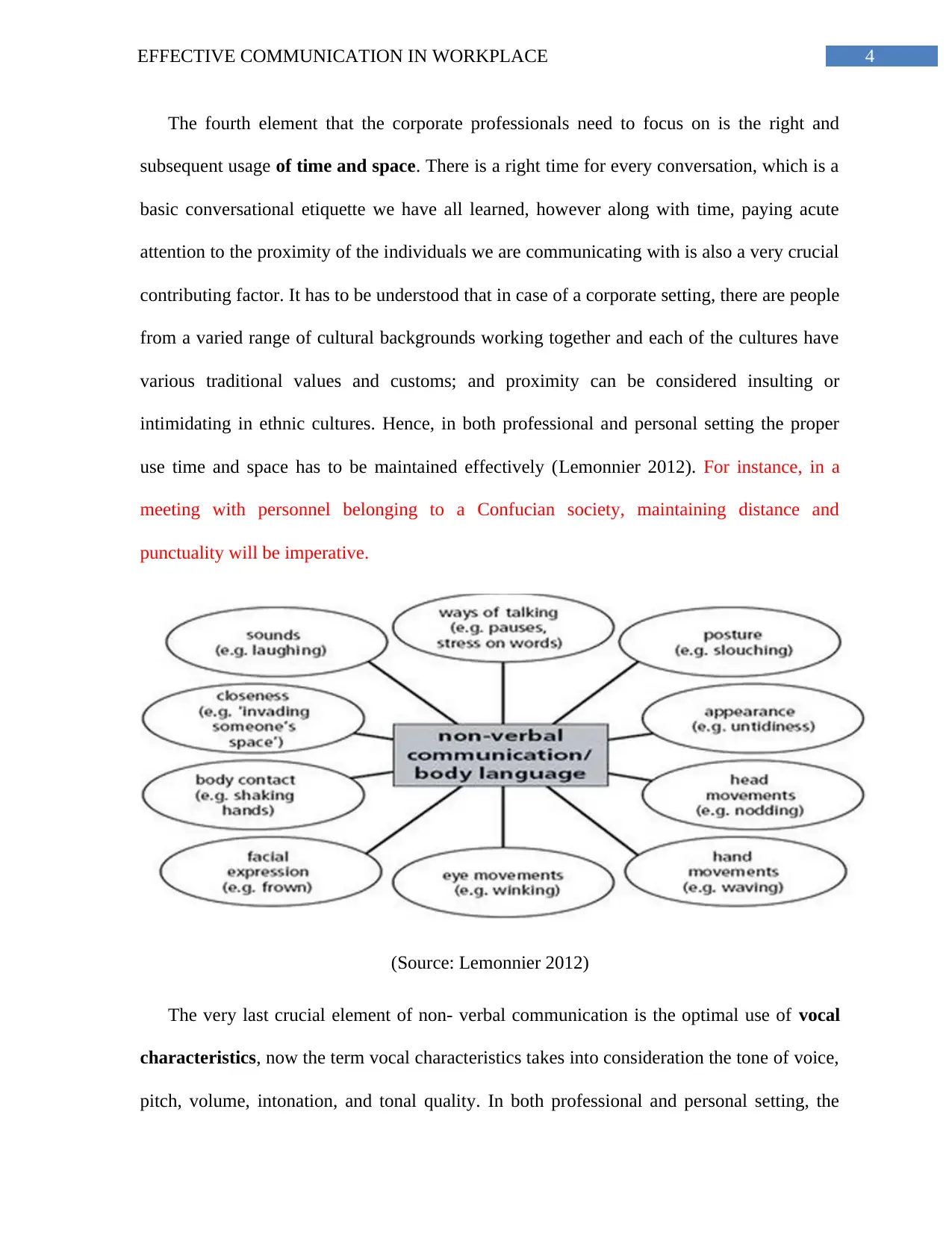
4EFFECTIVE COMMUNICATION IN WORKPLACE
The fourth element that the corporate professionals need to focus on is the right and
subsequent usage of time and space. There is a right time for every conversation, which is a
basic conversational etiquette we have all learned, however along with time, paying acute
attention to the proximity of the individuals we are communicating with is also a very crucial
contributing factor. It has to be understood that in case of a corporate setting, there are people
from a varied range of cultural backgrounds working together and each of the cultures have
various traditional values and customs; and proximity can be considered insulting or
intimidating in ethnic cultures. Hence, in both professional and personal setting the proper
use time and space has to be maintained effectively (Lemonnier 2012). For instance, in a
meeting with personnel belonging to a Confucian society, maintaining distance and
punctuality will be imperative.
(Source: Lemonnier 2012)
The very last crucial element of non- verbal communication is the optimal use of vocal
characteristics, now the term vocal characteristics takes into consideration the tone of voice,
pitch, volume, intonation, and tonal quality. In both professional and personal setting, the
The fourth element that the corporate professionals need to focus on is the right and
subsequent usage of time and space. There is a right time for every conversation, which is a
basic conversational etiquette we have all learned, however along with time, paying acute
attention to the proximity of the individuals we are communicating with is also a very crucial
contributing factor. It has to be understood that in case of a corporate setting, there are people
from a varied range of cultural backgrounds working together and each of the cultures have
various traditional values and customs; and proximity can be considered insulting or
intimidating in ethnic cultures. Hence, in both professional and personal setting the proper
use time and space has to be maintained effectively (Lemonnier 2012). For instance, in a
meeting with personnel belonging to a Confucian society, maintaining distance and
punctuality will be imperative.
(Source: Lemonnier 2012)
The very last crucial element of non- verbal communication is the optimal use of vocal
characteristics, now the term vocal characteristics takes into consideration the tone of voice,
pitch, volume, intonation, and tonal quality. In both professional and personal setting, the
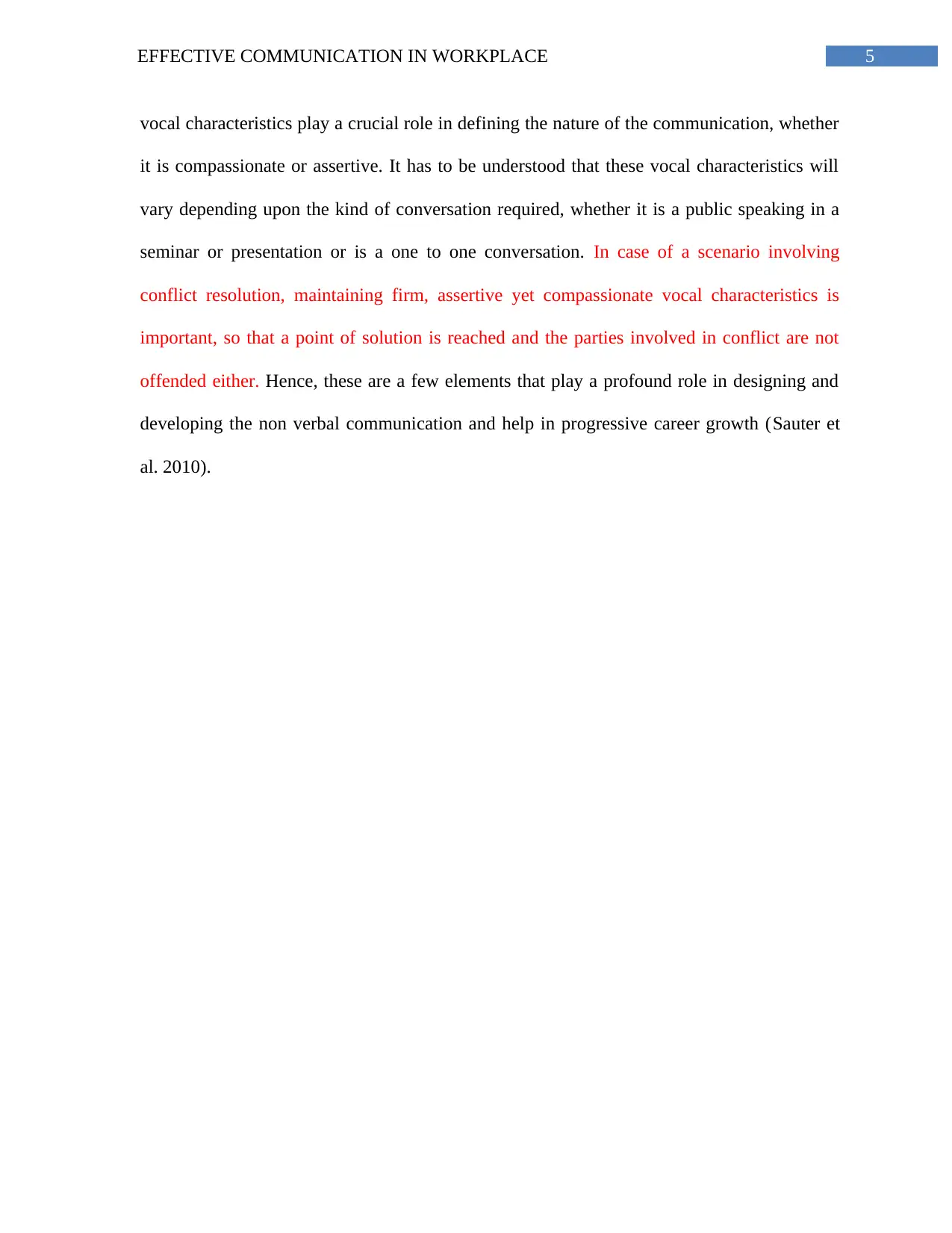
5EFFECTIVE COMMUNICATION IN WORKPLACE
vocal characteristics play a crucial role in defining the nature of the communication, whether
it is compassionate or assertive. It has to be understood that these vocal characteristics will
vary depending upon the kind of conversation required, whether it is a public speaking in a
seminar or presentation or is a one to one conversation. In case of a scenario involving
conflict resolution, maintaining firm, assertive yet compassionate vocal characteristics is
important, so that a point of solution is reached and the parties involved in conflict are not
offended either. Hence, these are a few elements that play a profound role in designing and
developing the non verbal communication and help in progressive career growth (Sauter et
al. 2010).
vocal characteristics play a crucial role in defining the nature of the communication, whether
it is compassionate or assertive. It has to be understood that these vocal characteristics will
vary depending upon the kind of conversation required, whether it is a public speaking in a
seminar or presentation or is a one to one conversation. In case of a scenario involving
conflict resolution, maintaining firm, assertive yet compassionate vocal characteristics is
important, so that a point of solution is reached and the parties involved in conflict are not
offended either. Hence, these are a few elements that play a profound role in designing and
developing the non verbal communication and help in progressive career growth (Sauter et
al. 2010).
⊘ This is a preview!⊘
Do you want full access?
Subscribe today to unlock all pages.

Trusted by 1+ million students worldwide
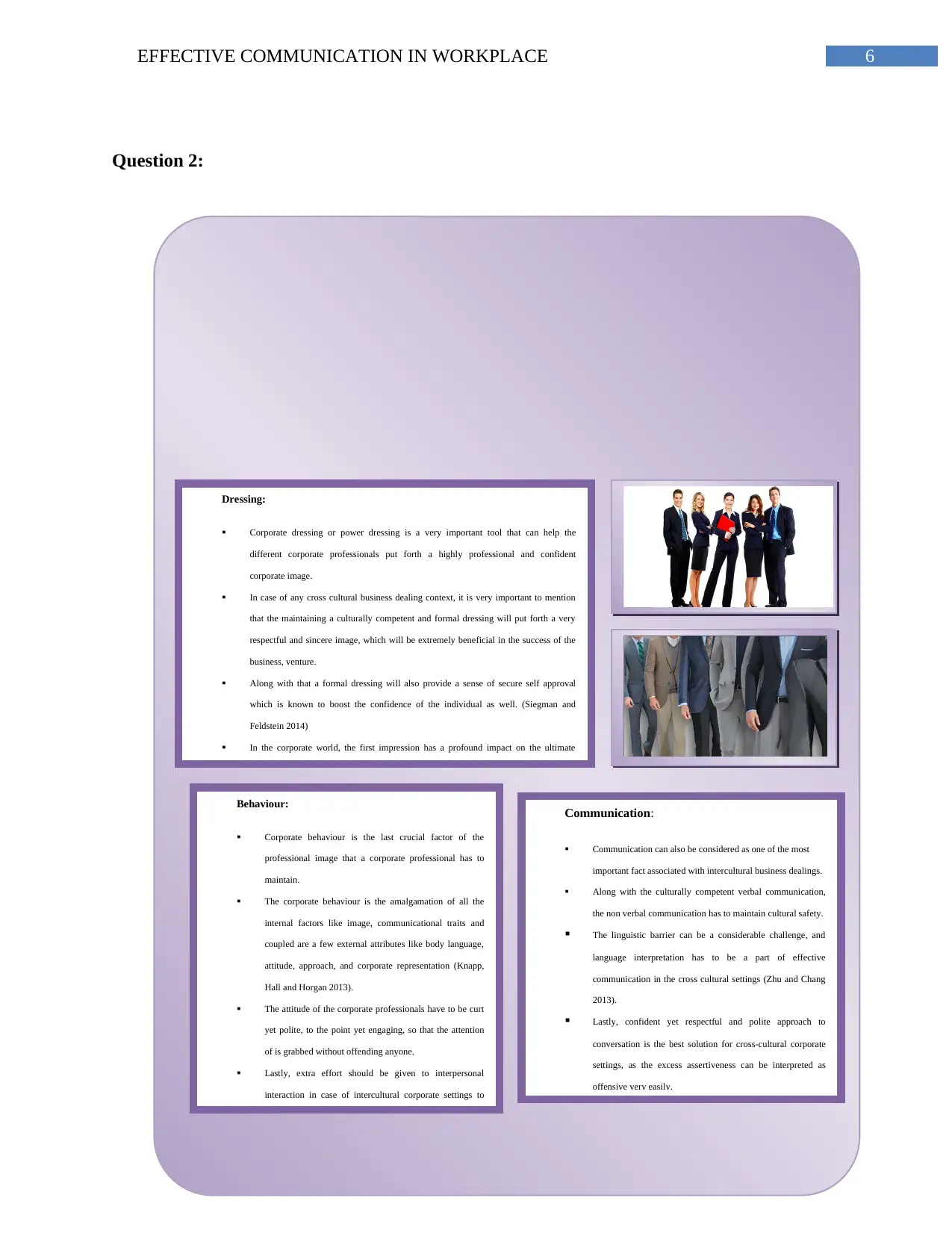
6EFFECTIVE COMMUNICATION IN WORKPLACE
Question 2:
In the present day business scenario, the globalization has taken
over the entire corporate world by a storm and as a result, cultural
diversity has become of the core elements of the corporate world
in the present day. Hence personal appearance and non-verbal
communication has become two most critical factors associated
with the concept of maintaining a corporate image. In addition,
there are three sectors where the individuals need to pay a little
Dressing:
Corporate dressing or power dressing is a very important tool that can help the
different corporate professionals put forth a highly professional and confident
corporate image.
In case of any cross cultural business dealing context, it is very important to mention
that the maintaining a culturally competent and formal dressing will put forth a very
respectful and sincere image, which will be extremely beneficial in the success of the
business, venture.
Along with that a formal dressing will also provide a sense of secure self approval
which is known to boost the confidence of the individual as well. (Siegman and
Feldstein 2014)
In the corporate world, the first impression has a profound impact on the ultimate
verdict. Hence a powerful corporate dressing will reflect a healthy and well coiffed
Communication:
Communication can also be considered as one of the most
important fact associated with intercultural business dealings.
Along with the culturally competent verbal communication,
the non verbal communication has to maintain cultural safety.
The linguistic barrier can be a considerable challenge, and
language interpretation has to be a part of effective
communication in the cross cultural settings (Zhu and Chang
2013).
Lastly, confident yet respectful and polite approach to
conversation is the best solution for cross-cultural corporate
settings, as the excess assertiveness can be interpreted as
offensive very easily.
Behaviour:
Corporate behaviour is the last crucial factor of the
professional image that a corporate professional has to
maintain.
The corporate behaviour is the amalgamation of all the
internal factors like image, communicational traits and
coupled are a few external attributes like body language,
attitude, approach, and corporate representation (Knapp,
Hall and Horgan 2013).
The attitude of the corporate professionals have to be curt
yet polite, to the point yet engaging, so that the attention
of is grabbed without offending anyone.
Lastly, extra effort should be given to interpersonal
interaction in case of intercultural corporate settings to
avoid conflict.
Question 2:
In the present day business scenario, the globalization has taken
over the entire corporate world by a storm and as a result, cultural
diversity has become of the core elements of the corporate world
in the present day. Hence personal appearance and non-verbal
communication has become two most critical factors associated
with the concept of maintaining a corporate image. In addition,
there are three sectors where the individuals need to pay a little
Dressing:
Corporate dressing or power dressing is a very important tool that can help the
different corporate professionals put forth a highly professional and confident
corporate image.
In case of any cross cultural business dealing context, it is very important to mention
that the maintaining a culturally competent and formal dressing will put forth a very
respectful and sincere image, which will be extremely beneficial in the success of the
business, venture.
Along with that a formal dressing will also provide a sense of secure self approval
which is known to boost the confidence of the individual as well. (Siegman and
Feldstein 2014)
In the corporate world, the first impression has a profound impact on the ultimate
verdict. Hence a powerful corporate dressing will reflect a healthy and well coiffed
Communication:
Communication can also be considered as one of the most
important fact associated with intercultural business dealings.
Along with the culturally competent verbal communication,
the non verbal communication has to maintain cultural safety.
The linguistic barrier can be a considerable challenge, and
language interpretation has to be a part of effective
communication in the cross cultural settings (Zhu and Chang
2013).
Lastly, confident yet respectful and polite approach to
conversation is the best solution for cross-cultural corporate
settings, as the excess assertiveness can be interpreted as
offensive very easily.
Behaviour:
Corporate behaviour is the last crucial factor of the
professional image that a corporate professional has to
maintain.
The corporate behaviour is the amalgamation of all the
internal factors like image, communicational traits and
coupled are a few external attributes like body language,
attitude, approach, and corporate representation (Knapp,
Hall and Horgan 2013).
The attitude of the corporate professionals have to be curt
yet polite, to the point yet engaging, so that the attention
of is grabbed without offending anyone.
Lastly, extra effort should be given to interpersonal
interaction in case of intercultural corporate settings to
avoid conflict.
Paraphrase This Document
Need a fresh take? Get an instant paraphrase of this document with our AI Paraphraser
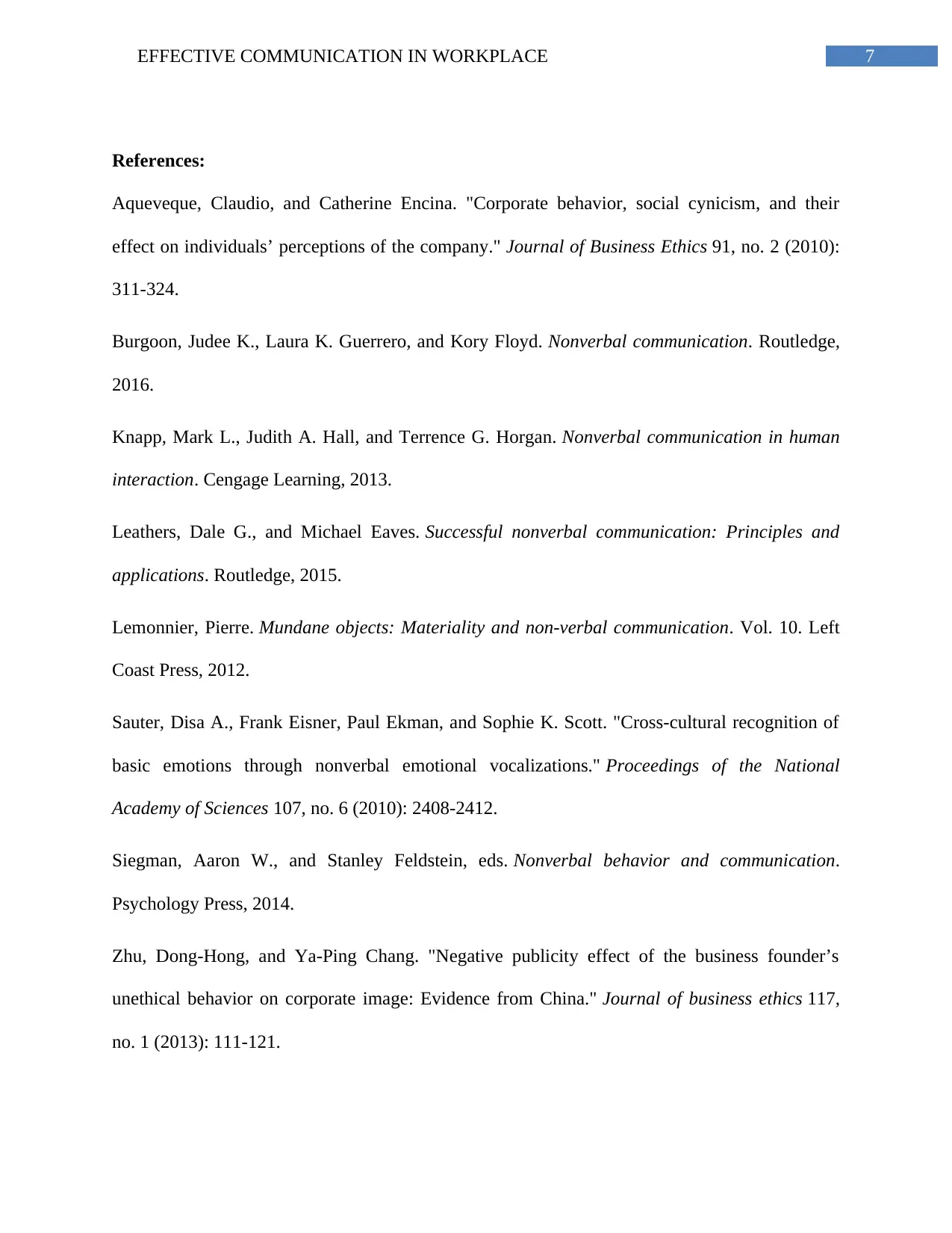
7EFFECTIVE COMMUNICATION IN WORKPLACE
References:
Aqueveque, Claudio, and Catherine Encina. "Corporate behavior, social cynicism, and their
effect on individuals’ perceptions of the company." Journal of Business Ethics 91, no. 2 (2010):
311-324.
Burgoon, Judee K., Laura K. Guerrero, and Kory Floyd. Nonverbal communication. Routledge,
2016.
Knapp, Mark L., Judith A. Hall, and Terrence G. Horgan. Nonverbal communication in human
interaction. Cengage Learning, 2013.
Leathers, Dale G., and Michael Eaves. Successful nonverbal communication: Principles and
applications. Routledge, 2015.
Lemonnier, Pierre. Mundane objects: Materiality and non-verbal communication. Vol. 10. Left
Coast Press, 2012.
Sauter, Disa A., Frank Eisner, Paul Ekman, and Sophie K. Scott. "Cross-cultural recognition of
basic emotions through nonverbal emotional vocalizations." Proceedings of the National
Academy of Sciences 107, no. 6 (2010): 2408-2412.
Siegman, Aaron W., and Stanley Feldstein, eds. Nonverbal behavior and communication.
Psychology Press, 2014.
Zhu, Dong-Hong, and Ya-Ping Chang. "Negative publicity effect of the business founder’s
unethical behavior on corporate image: Evidence from China." Journal of business ethics 117,
no. 1 (2013): 111-121.
References:
Aqueveque, Claudio, and Catherine Encina. "Corporate behavior, social cynicism, and their
effect on individuals’ perceptions of the company." Journal of Business Ethics 91, no. 2 (2010):
311-324.
Burgoon, Judee K., Laura K. Guerrero, and Kory Floyd. Nonverbal communication. Routledge,
2016.
Knapp, Mark L., Judith A. Hall, and Terrence G. Horgan. Nonverbal communication in human
interaction. Cengage Learning, 2013.
Leathers, Dale G., and Michael Eaves. Successful nonverbal communication: Principles and
applications. Routledge, 2015.
Lemonnier, Pierre. Mundane objects: Materiality and non-verbal communication. Vol. 10. Left
Coast Press, 2012.
Sauter, Disa A., Frank Eisner, Paul Ekman, and Sophie K. Scott. "Cross-cultural recognition of
basic emotions through nonverbal emotional vocalizations." Proceedings of the National
Academy of Sciences 107, no. 6 (2010): 2408-2412.
Siegman, Aaron W., and Stanley Feldstein, eds. Nonverbal behavior and communication.
Psychology Press, 2014.
Zhu, Dong-Hong, and Ya-Ping Chang. "Negative publicity effect of the business founder’s
unethical behavior on corporate image: Evidence from China." Journal of business ethics 117,
no. 1 (2013): 111-121.

8EFFECTIVE COMMUNICATION IN WORKPLACE
⊘ This is a preview!⊘
Do you want full access?
Subscribe today to unlock all pages.

Trusted by 1+ million students worldwide
1 out of 9
Related Documents
Your All-in-One AI-Powered Toolkit for Academic Success.
+13062052269
info@desklib.com
Available 24*7 on WhatsApp / Email
![[object Object]](/_next/static/media/star-bottom.7253800d.svg)
Unlock your academic potential
Copyright © 2020–2025 A2Z Services. All Rights Reserved. Developed and managed by ZUCOL.





